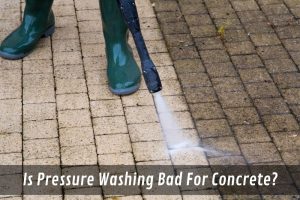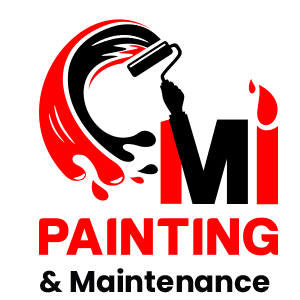Is Pressure Washing Bad For Concrete?

Pressure washing concrete is a popular method for homeowners and business owners to clean their outdoor surfaces, such as sidewalks, driveways or patios. However, many people wonder if pressure washing is bad for concrete and if it can cause damage. While pressure washing can be an effective way to remove dirt, grime, and stains from concrete, it can also cause potential damage if not done correctly. In this blog post, we will explore the pros and cons of pressure washing and provide tips for preventing damage while achieving a clean and well-maintained surface. Whether you are planning to pressure wash your concrete yourself or hire professionals for the job, this article will help you make informed decisions about how to keep your concrete surfaces clean and safe.
What are the pros and cons of using pressure washing on concrete?
Pros:
- Removes oil stains and dirt and debris
- Restores the appearance of the concrete surface
- Saves time and effort compared to manual cleaning
- Can be used on driveways, walkways, patios, and other surfaces
- Available through pressure cleaning services
Cons:
- High pressure can damage the surfaces, causing visible damage and erosion
- Using the wrong nozzle or holding the spot for too long can cause irreparable damage to the concrete
- Check your water supply as high water usage can lead to increased water bills
- The higher the number of pressure washes, the higher the risk of damaged concrete surfaces
- DIY pressure washing without proper knowledge and training can damage concrete driveways and walkways.
What are the factors to consider before pressure washing concrete?
Before pressure washing concrete, there are several factors you should consider to ensure that you achieve the desired results and prevent damage to the surface. Here are some of the key factors to keep in mind:
-
Age and condition of the concrete
If the concrete is relatively new and in good condition, pressure washing should not pose a problem. However, if the concrete is old, damaged, or has cracks, high-pressure water can exacerbate these issues.
-
Type of concrete
Different types of concrete may have different hardness, porosity, and texture, which can affect how they respond to pressure washing. For example, stamped or decorative concrete may be more delicate and require lower pressure settings.
-
Stains and contaminants
Consider the type and severity of any stains or contaminants on the concrete surface. Oil, grease, and rust stains may require special cleaning solutions or equipment to remove them effectively.
-
Surrounding landscapes and objects
Before pressure washing, take a look at the surrounding area and make sure there are no fragile plants, outdoor furniture, or other objects that could be damaged by the high-pressure water.
-
Water source and pressure settings
Ensure that you have the appropriate water pressure for the job and that your pressure washer is properly calibrated to avoid damaging the concrete. Using too much pressure can cause pitting or etching, while using too little pressure may not achieve the desired cleaning results.
-
Personal safety
Always wear protective gear such as gloves, eye protection, and closed-toe shoes when using a pressure washer. The high-pressure water can cause serious injuries if it comes into contact with your skin.
By considering these factors, you can determine whether pressure washing is a suitable method for cleaning your concrete surfaces and avoiding causing any unintended damage.
What are some best practices for pressure washing concrete?
Here are some best practices that are highly recommended for pressure washing using a power washer:
-
Pre-treat stains
Before using the power washer, pre-treat any stains or oil spots on the concrete surface with a cleaning solution or detergent specifically designed for concrete.
-
Use the correct nozzle
Use the correct spray nozzle for the job, typically a 25-degree nozzle is ideal for concrete. Using the wrong nozzle can lead to uneven cleaning or cause damage to the concrete surface.
-
Keep a safe distance
Maintain a safe distance between the nozzle and the concrete surface to prevent damage. A distance of at least 12 inches is recommended.
-
Use appropriate pressure settings
Adjust the pressure setting on the power washer based on the condition of the concrete surface. The lower pressure may be needed for more delicate surfaces or older concrete.
-
Work in sections
To avoid streaking or uneven cleaning, work in sections and overlap each section as you go.
-
Keep the power washer moving
Avoid holding the power washer nozzle in one spot for too long as it can cause damage to the surface.
-
Rinse thoroughly
Once the cleaning is complete, rinse the entire surface thoroughly to remove any remaining dirt or debris.
By following these best practices, you can achieve effective and safe results when pressure washing concrete with a power washer.
In conclusion, pressure washing can be an effective and efficient way to clean concrete surfaces, but it can also cause potential damage if not done correctly. Excessive pressure can chip, crack, or damage the concrete surface, making it necessary to use a finer nozzle and appropriate pressure settings. It is important to use the right cleaning solution and keep a safe distance to avoid damaging the surface. Professional concrete cleaning services are highly recommended for homeowners who are unsure about pressure washing or want to maintain the curb appeal of their property. With the help of experienced professionals, homeowners can have their concrete surfaces cleaned effectively and safely without causing any damage. By hiring professionals for pressure cleaning, homeowners can enjoy a well-maintained property that looks clean, fresh, and welcoming, enhancing the curb appeal of their homes.
Contact Mi Painting today to learn more about pressure washing service and how we can help keep your concrete surfaces looking great.
